
What to Know About the Judicial Branch Budget
Governor Gavin Newsom on Monday signed a budget that includes $1.2 billion in new funding for the judicial branch, supporting many longstanding priorities of Chief Justice Tani Cantil-Sakauye and the Judicial Council of California to expand access to justice.
Said Chief Justice Cantil-Sakauye:
This year’s budget represents an unprecedented
investment in our judicial branch, and I thank the Governor and Legislature for their continued dedication to providing access to justice with sustainable funding for our courts.
In supporting access to justice, this budget will fund significant investments in technology, provide critically needed judgeships and courthouses, and expand remote access to court proceedings that played a key role during the pandemic.
As we emerge from the effects of the pandemic, this historic budget will benefit all Californians who depend on a functioning justice system.”
Here are some of the key areas receiving new funding:
- $184 million in ongoing funding for the trial courts, $100 million of which will be allocated by the Judicial Council to continue to promote fiscal equity among California’s 58 trial courts.
- 23 new judgeships, many in the fastest growing parts of the state in need of more judges to keep up with caseloads.
- A pending bill (AB 199) would allow criminal defendants to consent to remote hearings in misdemeanor and felony proceedings, except for trial and felony sentencing, through Jan. 1, 2024. The Judicial Council in 2020 approved emergency rules allowing courts to require judicial proceedings and court operations be conducted remotely, which expires June 30. A report showed remote hearings allowed California trial courts to resolve a far larger percentage of certain case types during the pandemic.
- Five new courthouse projects: a new Santa Clarita Courthouse (Los Angeles); Quincy Courthouse (Plumas); Solano Hall of Justice in Fairfield; Fresno Courthouse; and San Luis Obispo Courthouse. Another $15 million will be used to expand lactation facilities in the courts.
- $110 million this year and $100 million ongoing to offset the lowering of civil assessments from $300 to $100 and sweeping past debt, as the branch continues to push for sustainable funding sources amid concern of the disparate impact of civil assessments on low-income Californians. Fee revenues would now go directly to the state’s general fund.
- Another $151.5 million would go to offset the expected decline in fine and penalty revenues, and $18 million ongoing backfill branch funds related to an increase in the income threshold for automatic filing fee waivers in civil cases.
- Support for the Governor’s proposed CARE Act that seeks to address the needs of people living with untreated mental health and substance abuse challenges. The funds ($39.5 million for the upcoming budget year and $37.7 million annually going forward) on would address costs to the judicial branch related to conducting additional hearings, expanding self-help centers, supporting program administration at the trial courts, and updating court case management systems.
- $34.7 million for technology modernization to expand public access to digital records and court proceedings through electronic case filing, digitizing court documents, enabling online dispute resolutions, and enhancing remote proceedings. Another $33.2 million will be used to provide a publicly accessible audio stream for every courthouse in the state.
- $1.2 million ongoing to establish a Judicial Council climate change unit to provide training, technical assistance, and legal support to California’s trial courts on environmental and climate change issues.
- The budget bill establishes an annual report from the Judicial Council to the Legislature by Feb. 1 with various trial court metrics, including: the amount of time to case disposition or completion; case clearance rates and backlogs by case type; hours of operation including public counter hours, staff vacancy rates; and more.
- Funding for some of the most vulnerable Californians, including: expanding legal aid with $30 million slated for eviction defense and $15 million for consumer debt protection; $39 million for dependency counsel, and $20 million in support of Court Appointed Special Advocates (CASA). Another $8.3 million ongoing will support the Court Appointed Counsel Program for the Courts of Appeal.
See the full judicial branch budget at www.ebudget.ca.gov/.


